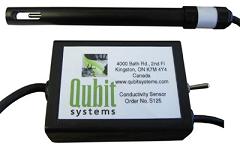
This probe is great for environmental testing for salinity, total dissolved solids (TDS), or conductivity in water samples. Biology teachers can use this probe to demonstrate diffusion of ions through membranes or to monitor changes in ion levels in aquatic systems. Chemistry students can use it to investigate the difference between ionic and molecular compounds, strong and weak acids, or ionic compounds that yield different ratios of ions. The Conductivity Probe can monitor concentration or conductivity at three different sensitivity settings.
You can take readings in units of conductivity (µS/cm) or concentration (mg/L TDS as NaCl). The Conductivity Probe can monitor conductivity at three different sensitivity settings:
0-100 mg/L TDS or 0-200 µS/cm
0-1000 mg/L TDS or 0-2000 µS/cm
0-10000 mg/L TDS or 0-20,000 µS/cm
Conductivity is directly proportional to concentration over the entire range.
The probe has a fast response time, reaching 98% of full value in less than 5 seconds. You can load saved calibrations using any of the Vernier data-collection programs. Alternatively, you can do a quick two-point calibration: the probe is left out of solution for one calibration point (0 µS/cm) and is placed in a known standard (1000 µS/cm solution is provided) for a second calibration point. More precise calibration in two different standards is also possible using our software.
The Conductivity Probe uses alternating current at its electrodes; this prevents polarization and electrolysis, so that solutions being tested are not fouled. Corrosion of metal electrodes is not a problem with this epoxy-body graphite electrode. It has built-in temperature compensation, which allows you to do your calibrations in the lab, and then make measurements outdoors without temperature changes affecting conductivity readings.
The Conductivity Sensor comes with a Sodium Chloride Calibration Standard (equivalent to 1000 uS/cm, 491 mg/L as NaCI, or 500 mg/L TDS) and the Conductivity Sensor Manual.
Producing Area:Canada